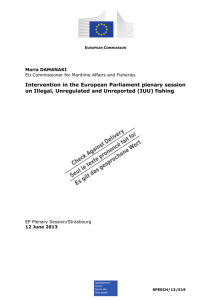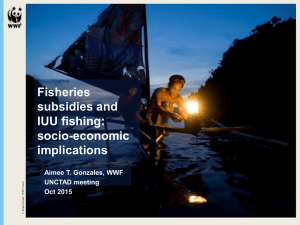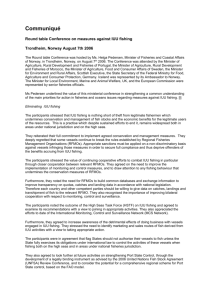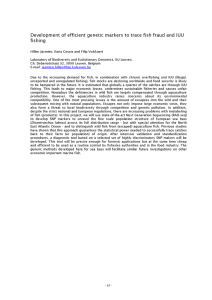Incentives for Investment in IUU Fishing Capacity The Economics of Illegal Fishing
advertisement
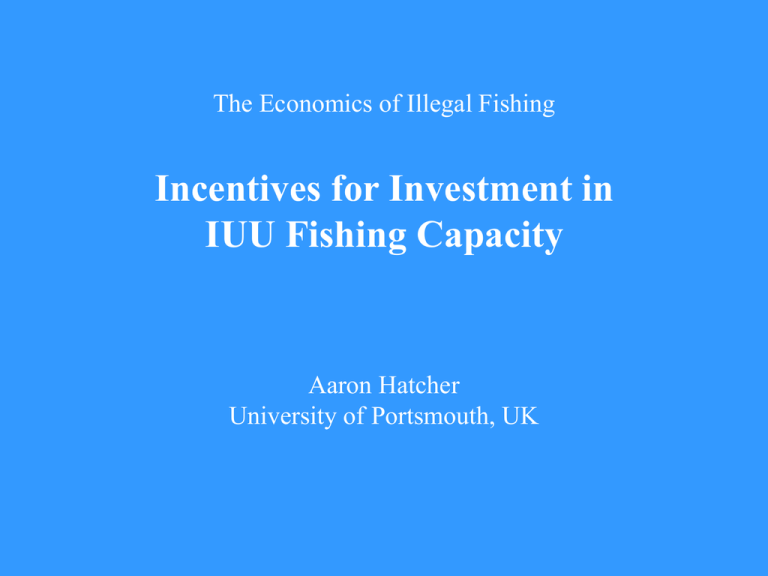
The Economics of Illegal Fishing Incentives for Investment in IUU Fishing Capacity Aaron Hatcher University of Portsmouth, UK Is IUU fishing likely to be driven by a “spillover” of excess capacity from regulated (EEZ) fisheries? Focus of the paper • FAO definition of IUU as “Illegal, Unreported and Unregulated” is inclusive • Focus on vessels with no access rights, operating outside any normal regulatory environment, e.g., FONC vessels in international waters • In the absence of management, fishing effort is (only) determined by market forces, e.g, the supply of fishing capacity What do we mean by “capacity”? • Capacity is a measure of output, not capital stock • Fishery managers generally use “capacity” to refer to physical capital and its output • All else equal (technology, prices, etc.), physical capital and (unconstrained) output are closely related • Capacity ≈ physical capital Analysis of the question • Consider investment in IUU fishing as a normal investment decision • The decision to invest depends upon (expected) benefits and costs • Assume, e.g., no non-pecuniary motivation against (or for) illegal fishing A simple investment model T T PV t K pt qt K ct K t t 1 t t 1 at t = 0, where total operating costs ct are given by… c t K c K c K c K c K c K r t c t m t a t p t where the cost categories are denoted r normal running costs (fuel, ice, etc.) c crew costs m routine maintenance costs (repairs, safety equipment) a administrative costs (registration, insurance, etc.) p permit and quota (management) costs The total expected return (ER) is T ER t K CT t T t 1 where CT is the value of the capacity at time T Taking account of the inherent riskiness of investing in fishing, the value of fishing capacity is given by ER less a risk premium R T C0 t K CT R t T t 1 • C0 is equivalent to the willingness to pay (WTP) for an investment in capacity K • In a perfect market at equilibrium, C0 will be the (purchase) cost of capacity K • For those already in the fishery, C0 is the opportunity cost of capacity K Benefits and costs of IUU fishing • high-value species, therefore high revenues if there is access to markets? • running costs: fuel, ice, etc., at normal prices? • crew costs: mostly low cost labour? • maintenance: lower (weak flag requirements)? • administrative costs: lower (weak flag requirements)? • management costs: zero? Benefits and costs of IUU fishing • Revenues: the same or higher than in a legal fishery? • Operating costs: the same or lower than in a legal fishery? • Assume the end value of capacity is independent of its mode of use • Difference in WTP for legal and IUU capacity depends on costly enforcement events… • …an “excess risk premium” RE C C RE I 0 L 0 • Expected returns from IUU fishing are only lower than in a similar legal fishery if RE is high • If expected returns are high, WTP for capacity is high • Unless RE is high, IUU investors’ WTP for capacity will match normal market prices… • …availability of “cheap” capacity is not necessary for investments in IUU fishing C0 Cost of capacity DN DS SN SS 1 SS 2 0 K1 K2 Quantity of capacity K IUU capacity demand and supply: scenario 1 • Secondhand capacity prices are not determined by demand from IUU investors (why?) • Demand for capacity by IUU investors is price inelastic • Availability of cheap capacity has only marginal impact on total IUU capacity… • … but delivers a “windfall gain” to IUU operators C0 Cost of capacity SN SS 1 DS SS 2 0 K1 K2 Quantity of capacity K IUU capacity demand and supply: scenario 2 • Secondhand capacity prices might be determined (in part) by demand from IUU investors • Demand for capacity by IUU investors is price elastic • Availability of cheap capacity has a significant impact on total IUU capacity… • … and so is a key “driver” of IUU fishing Conclusions • Available evidence suggests that IUU fishing is profitable • A “spillover” effect from overcapacity in regulated fisheries is unlikely • Key to reducing profitability of IUU fishing is increased likelihood of costly enforcement events and/or denial of access to markets • Only then would “cheap” capacity be a significant driver of IUU fishing
